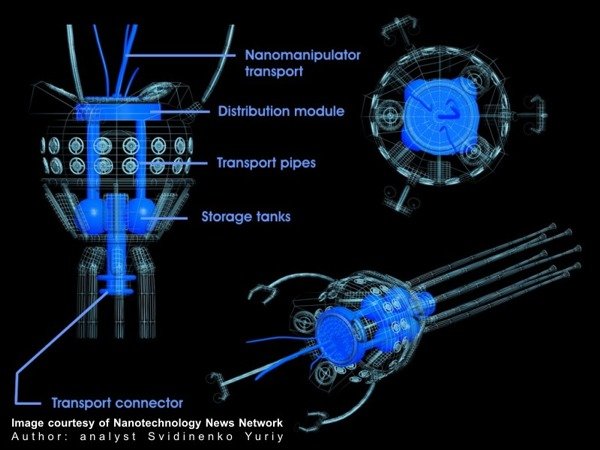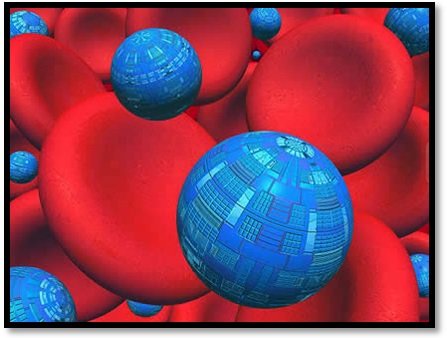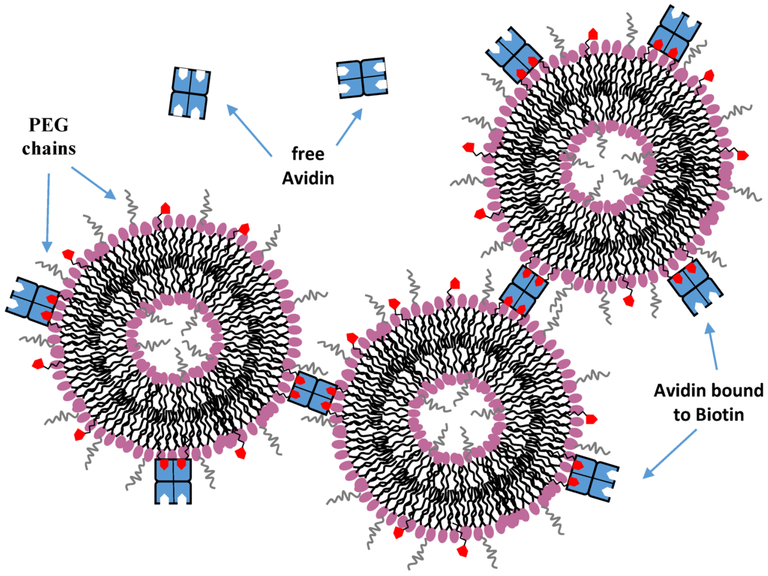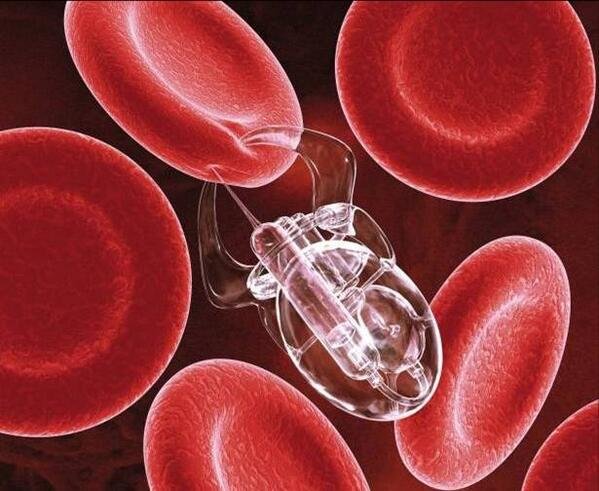Nanorobots: Part 1 - The Medicine of the Future
The purpose of this publication is to discover the promising field of nanotechnology applied to medicine by the use of nanorobots as instruments to achieve a targeted therapy that guarantees the effectiveness of the treatment of diseases of great importance at present, either because of its prevalence , incidence, its high mortality or morbidity, or the great economic investment that the current treatment upposes.
Structure of a nanorobots
source

The nanorobots also called nanobots, nanorods, nanites, nano agents or nanomachines; they are mechanical devices of nanometric dimensions. They can also be defined as artificially manufactured objects capable of freely diffusing in the human body and interacting at the molecular level with a specific cell. Thus, nanorobots can be directed not only to a specific tissue or organ but individually, to cells within a tissue or organ that exhibit a particular characteristic that differentiates them.
• Types of nanorobots
There are different classifications of nanorobots according to their nature, their characteristics or the function they perform.
The First classification, according to its nature:
Organic: also called bionanorobots, which are created using cells provided with viral or bacterial DNA. These are less toxic to the body.
Inorganic: created by diamond structures, by protein synthesis or other types of materials. They are more toxic. The way to reduce the toxicity is encapsulating the nanorobot, in such a way that it evades the immune system.
The second classification is based on two properties:
- Assemblers: are nanorobots in the form of simple cells, which may be able to decipher molecules or atoms, and are controlled by specific programs. By their use, they are also called molecular assemblers, as a reference to ribosomes, which are the natural "assemblers".
Self-replicating: essentially nanorobots capable of duplicating (self-replicating) themselves at high speed. This type of duplication helps the construction of large-scale applications or deployment of nanorobots for large-scale tasks.
We emphasize the third classification based on its applications in artificial blood:
a) Farmacitos: of 1-2 micrometers of size, with a capacity to store 1 micrometer cubic of a drug. They are provided with molecular markers or chemotactic sensors that guarantee the reach of the pharmacy to the therapeutic target. They take the energy of glucose and oxygen extracted from the local environment, such as the blood, intestinal fluid or cytosol of the cell. After the nanorobot reaches the target and releases the drug, it will be recovered by anaphoresis.
b) Respirocitos: are the nanorobots designed to carry out the functions of the red blood cells, they transport oxygen and carbon dioxide, so they release 236 times more oxygen to the tissues of the body than the natural red blood cells. The respirocyte detects the acidity of the blood, by concentration sensors and the onboard nanocomputer processes the signal. The gas concentration sensors are located on the surface of the respirocyte. Once the concentrations are detected, it performs gas exchange by molecular pumps or rotors. So that each respirocyte contains three rotors: one releases the oxygen stored while traveling through the body, another captures the carbon dioxide from the blood and directs it to the lungs while the third rotor takes glucose from the bloodstream to use it as fuel.
When the respirocyte passes through the pulmonary capillaries and detects the difference in concentration of oxygen and carbon dioxide, the nanocomputer starts the rotors to capture the oxygen and release the molecules of carbon dioxide that it has previously captured in the tissues.
Respirocytes sailing in the bloodstream
source

c) Clotocitos: nanorobots with a single biological function to achieve an immediate hemostasis. They are artificial platelets. The entire process of natural coagulation lasts about 2-5 minutes. The lobes reduce the clotting time and blood loss. Some patients have irregularities in the coagulation process, this is usually treated with corticosteroids that produce numerous adverse effects such as hormone secretion, lung damage, and allergic reactions. The greatest risk associated with the clotocitos is that the additional activity of the mechanical platelets triggers the intravascular dissemination of the coagulation producing multiple microthrombi.
source

d) Microbivores: nanorobots with specific functions of white blood cells, known as artificial phagocytes, 3.4 micrometers in diameter on its major axis and 2 micrometers on its minor axis. They trap the pathogen present in the bloodstream and break it down into small molecules. The main function is to absorb and digest the pathogen through the phagocytosis process.
The microbivore consists of:
- A set of multiple reversible binding sites.
- A set of telescopic arms
- Chamber of crushing
- Digestion chamber
The bacterium binds to the surface of the microbivore in a specific way by the reversible binding site. The telescopic arms go to the surface and attack the bacteria causing their anchoring. The bacterium is internalized to the crushing chamber where it is reduced to amino acids, mononucleotides, free fatty acids and simple sugars; which are digested in the digestion chamber by pre-programmed digestive enzymes. After the destruction of the pathogen, the microbivore is excreted by the kidneys.
The complete cycle of phagocytosis by a microbivore is completed in 30 seconds. There is no possibility of septic shock or sepsis by internalizing and digesting the bacterial components to non-antigenic biomolecules. The microbivore is 1000 times faster than antibiotics, besides, it does not present the possibility of developing resistance.
Nanorobots microbivore
source

• Advantages and disadvantages of the use of nanorobots
Advantage:
It is durability. In theory, they are capable of presenting operability for years or decades.
A nanoscale can operate much faster because the displacements are smaller.
They can produce copies of themselves to replace worn out units: self-replication process.
They do not produce traumas at the tissue level or they are minimal.
The recovery times in the disease are much shorter.
Much less post-treatment care is required
Continuous monitoring and continuous diagnosis are obtained in real time from inside the organism.
You can respond quickly to a sudden change.
Disadvantages
They present a high cost and would require many years of work until being implanted.
They are complex in nature, they will be difficult to interconnect, personalize and design.
Electric systems create scattered fields that can activate molecular recognition systems.
Electric nanorobots are susceptible to electrical interference from external sources.
They represent a potential risk of lack of privacy.
Terrorism: molecular weapon.
• Applications
The main objective of the development of nanotechnology applied to the pharmacy is the prevention and treatment of diseases. The use of nanorobots allows to control the release of drugs in chronic patients; In addition, nanorobots can be used to repair damaged cells and tissues. The application of nanorobots in medicine allows us to treat a pathology before it is serious and irreversible. Early diagnosis prevents the chronification of the disease.
The protocol of action would be the following:
- Introduce the nanorobot in the body by intravenous injection.
- Store and process the data collected by the nanorobot, identify the patterns and help predict the onset of the disease.
- Guide the nanorobots and direct them to the therapeutic target.
- The release of drugs in the place of action.
- Recovery of the nanorobot by common excretion pathways, by nanophoresis, or collection systems called nano terminators can be used.
source

Informations
https://en.wikipedia.org/wiki/Nanorobotics
http://www.dummies.com/education/science/nanotechnology/types-of-nanorobots-being-developed-for-use-in-healthcare/
https://www.researchgate.net/publication/311941829_Nanorobotics_in_Drug_Delivery_Systems_for_Treatment_of_Cancer_A_Review
http://www.nanomedicine.com/Papers/ProgressNM06.pdf
http://www.nanomedicine.com/Papers/Aging.pdf
The future looks very good!

That's right, what technology can do for us today is great.
How big the technology is, it is unimaginable everything you can do for us. I loved this theme. Especially because it is interesting how a robot model can help you survive in various diseases.
Thank you for reading the article, I also found it interesting to share it with you, since it is very important to know how important technology is today and all the help you can give us for the day to day and our health, since without we do not do anything